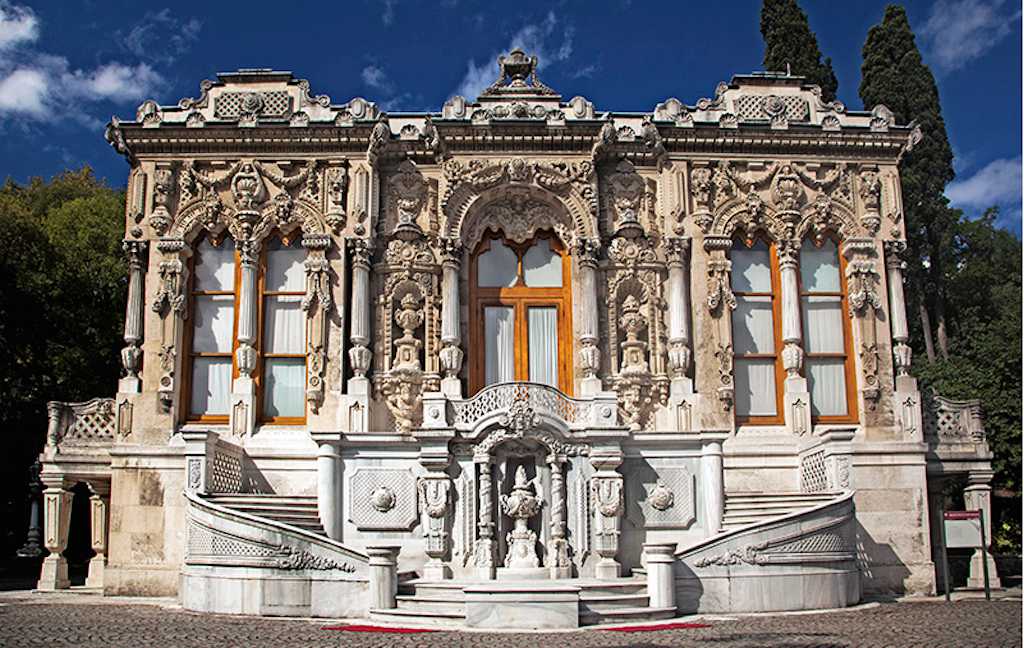
the Recreation Area and the Boarding Pavilion of the Sultans
Ihlamur Pavilions, one of the boarding pavilions used by the sultans for daily recreation during the Ottoman period, are cited among the most elegant examples of 19th century Ottoman buildings, characterized by architectural features bearing the traces of the Neo-Baroque movement. The recreational area of greenery in the Ihlamur Valley was known as Hacı Hüseyin Farms, located in the middle of the triangle of Beşiktaş, Yıldız and Nişantaşı, named after its original owner Hacı Hüseyin Ağa, the treasurer of the shipyard. The farms were later transferred to state ownership and were transformed into a royal garden, with a wooden mansion built for the sultans to rest.

In 1791, Sultan Selim III had expanded the garden by having several pools and buildings built. The valley, recorded as being a shooting and training place for the sultans, was frequently visited by Abdülhamid I, Selim III and Mahmud II. Some surviving target stones bear the date and scores of the shots of the sultans Selim III and Mahmud II, indicating shooting competitions in the upper part of Ihlamur Valley towards Yıldız.

The pavilion of joy and happiness: Nüzhetiye
The Ihlamur buildings were ordered by Sultan Abdülmecid to be built by Karabet Balyan, one of the most famous architects of the period and the palace foreman. Constructed in the period from 1849 to 1855, the landscaping was done by the German gardeners working at the Dolmabahçe Palace.

Sultan Abdülmecid saw the name “Nüzhetiye”, meaning “freshness, joy and happiness,'' appropriate for the region where Ihlamur Pavilions are located. Situated on an area of 24,724 square meters, the Ihlamur Pavilions consist of two structures, one for the official works and ceremonies of Sultan Abdülmecid, the Ceremony Pavilion, and the other for the Sultan's entourage and occasionally for the harem, the Retinue Pavilion.

Traces of Baroque period in Ottoman architecture
The Ceremony Pavilion has a striking and ornate appearance. The Baroque architectural mentality is visible in the design of the two-armed staircase in front of the building and the façade of the mansion, the decorations of the rooms on both sides of the entrance hall and in the furniture. The Ceremony Pavilion, which is surrounded by cut stone and decorated mainly with marble, can be visited as a museum today.

The Retinue Pavilion has a two-armed staircase similar to the one in the Ceremony Pavilion, although it has been designed with a simpler and more traditional approach than its counterpart. The upstairs hall is surrounded by four rooms of the same size. The walls of these rooms are covered with different colored stuccoes. Today, the garden of the Retinue Pavilion serves as a resting place.

During the reign of Sultan Abdülaziz, who ascended to the throne after the death of his brother, Sultan Abdülmecid, Ihlamur Pavilion was the venue of various entertainment events and wrestling tournaments. Frequently visited by the sultan and his entourage, Ihlamur Pavilions were granted to the Grand National Assembly of Turkey on March 3, 1924. The compound was allocated to the Istanbul Municipality in 1951, finally being transferred to National Palaces in 1966. The buildings, which were opened to visitors as a museum-palace in 1985, have reached their present appearance when the restoration works were completed in 1987.

written by Directorate of National Palaces
天有不测,及时享乐!